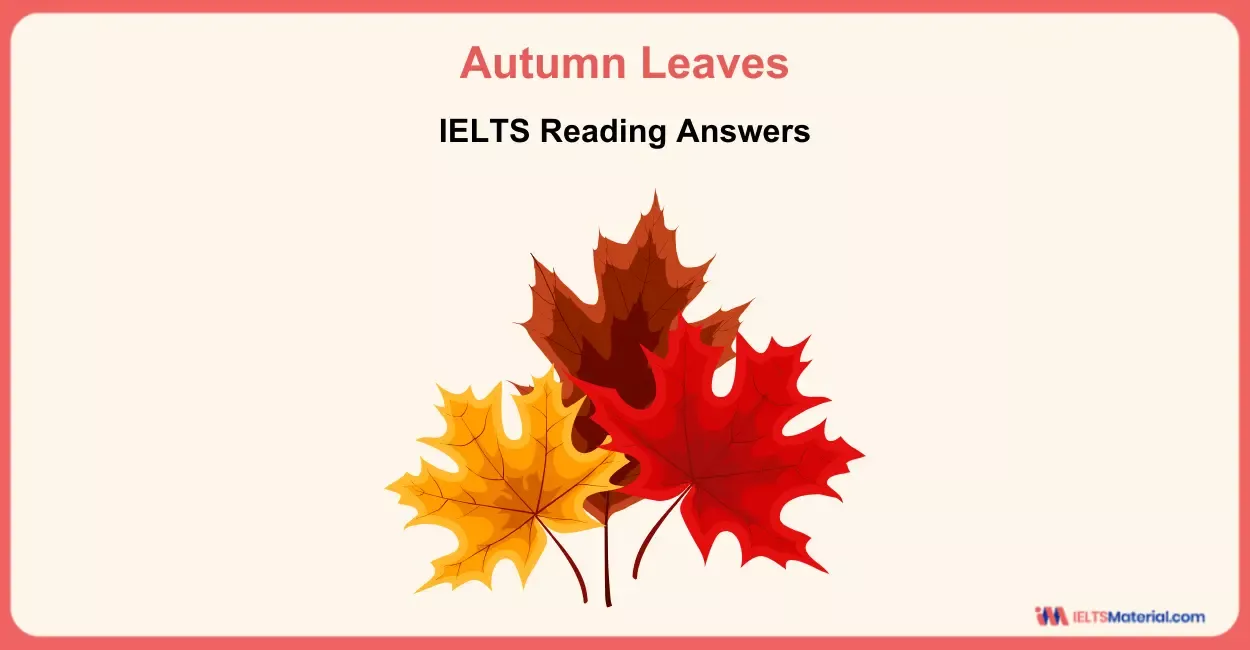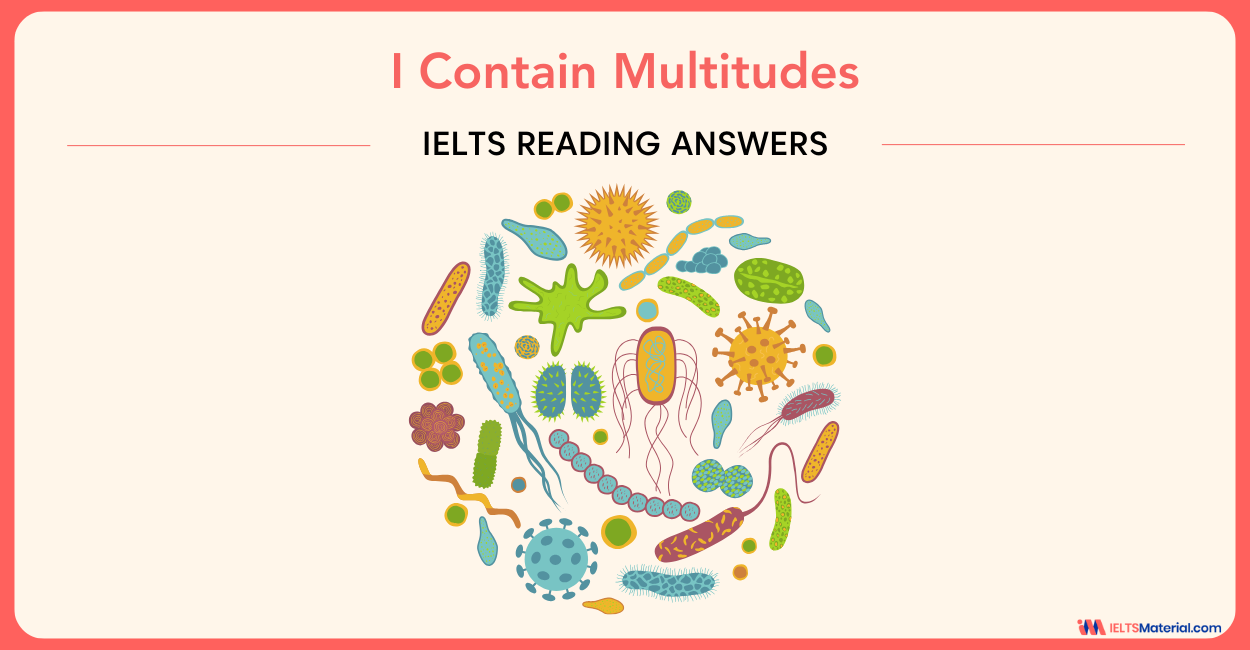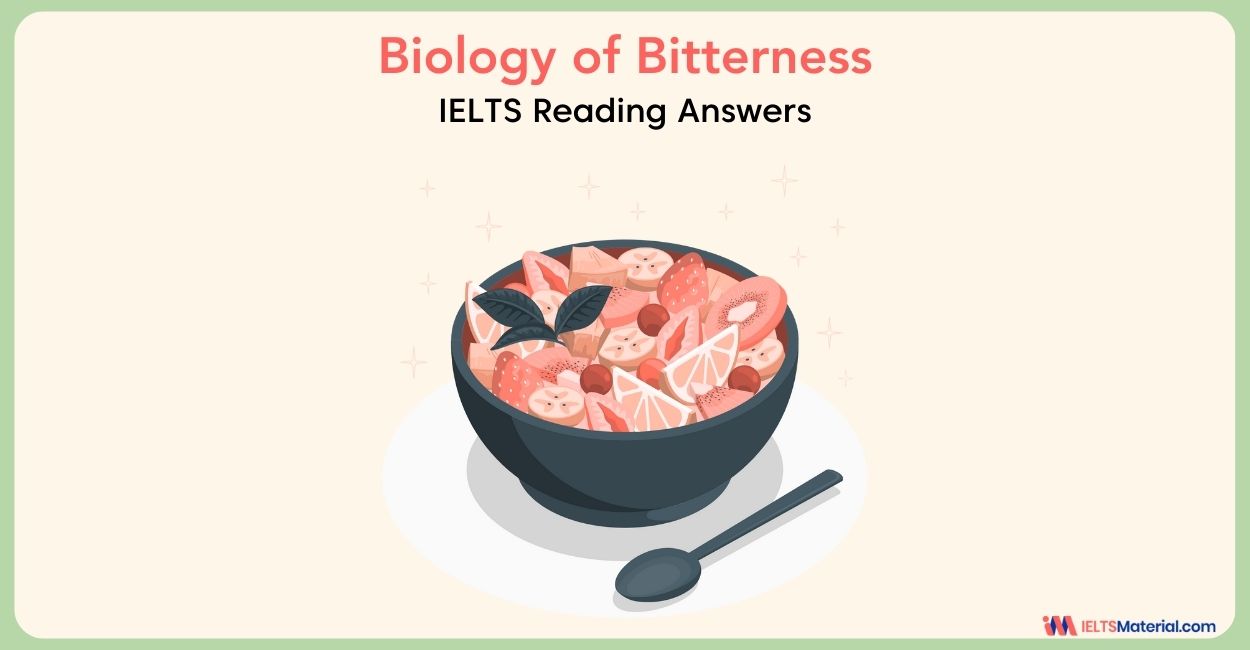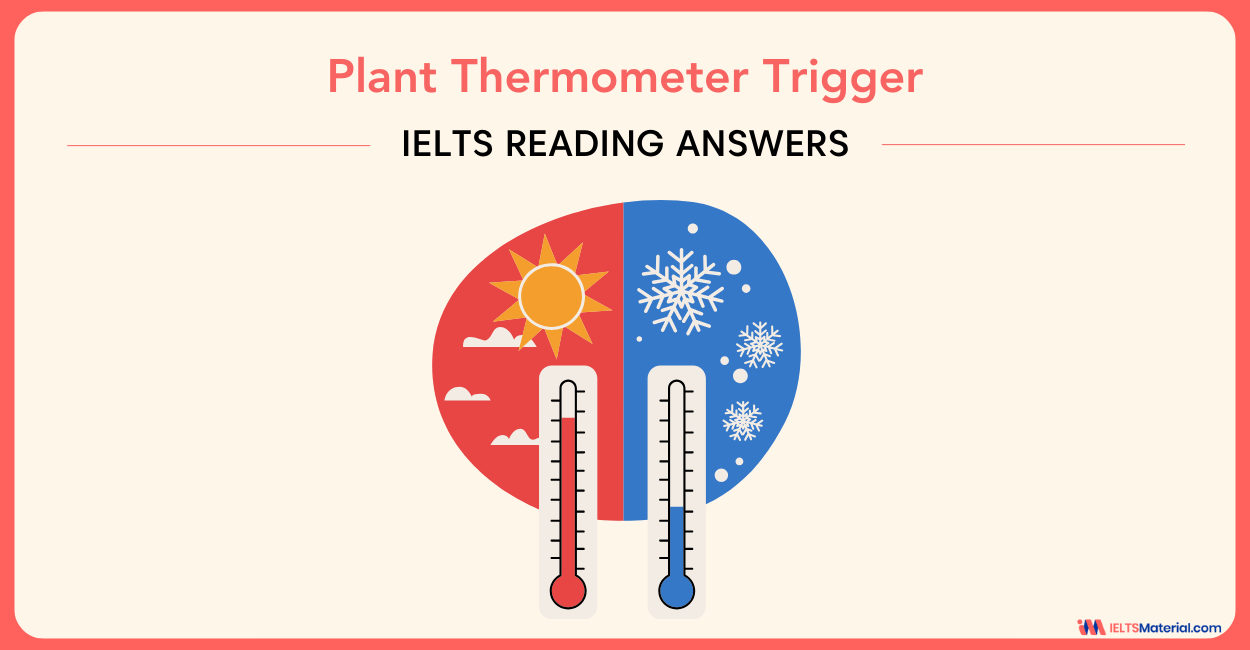Plant Thermometer Trigger – IELTS Reading Answers
12 min read
Updated On
-
Copy link
Indulge yourself with the strategies to attempt different question types for the passage on 'Plant Thermometer Trigger – IELTS Reading Answers' and enhance your reading skills to achieve a band 8+ in the IELTS exam.
Table of Contents

Limited-Time Offer : Access a FREE 10-Day IELTS Study Plan!
The Academic Reading passage on ‘Plant Thermometer Trigger’ would help you to be aware of the question types which you will encounter. The Reading module will assess your ability to read, understand, and interpret as well as comprehend the information provided in the passages. The IELTS Reading section tests various skills such as identifying main ideas, locating specific information, following arguments, and recognizing the writer’s opinion or purpose.
If you keep practicing on a regular basis, you will get a clear idea of the types of questions which might be asked in the passages. This section might seem intimidating but you can turn this into an opportunity to score a band 8+ in the IELTS Exam. With focused strategies and tips, you can build confidence for the test day and complete answering questions within the specified time limit.
So, let's check out the passage on 'Plant Thermometer Trigger – IELTS Reading Answers'.
Connect with our band 9 IELTS Trainers to crack your IELTS Reading in no time! Book a FREE Demo.
Types of Questions in Plant Thermometer Trigger – IELTS Reading Answers
Before attempting the passage on 'Plant Thermometer Trigger – IELTS Reading Answers', you must first know the question types and the specific strategies to be used for each of them. This will enhance your reading skills and also help you in preparing with a targeted study. Focus on understanding how to attempt these questions before diving into the passage.
The question types found in the ‘Plant Thermometer Trigger’ passage are:
- IELTS Reading True False Not Given (Q. 1-5)
- IELTS Reading Matching Features (Q. 7-11)
- IELTS Reading Sentence Completion (Q. 12-14)
Want to boost your IELTS Reading score? Check out the video below!
Tips for Answering Plant Thermometer Trigger – IELTS Reading Answers for a Band 8+
As you attempt the questions, it is necessary to use a few tricks to that you can spot the answers effectively. Even though the answers are provided, it is crucial to attempt the questions yourself first before you check out the answers. In this way, you will be able to simulate the exam environment so that you can confidently approach them within the time limits. Let us check out some quick IELTS Exam Preparation Tips for Band Score of 8+ and prepare yourself to answer the types of questions in the ‘Plant Thermometer Trigger’ Reading passage.
- Put the timer on as you attempt the passage. This will help identify the total time which you take to attempt questions.
- True/False/Not Given questions are a type of IELTS Reading question that requires you to identify whether a statement is true, false, or not given in the passage. Remember that true statements are statements that are explicitly stated in the passage. False statements are statements that are explicitly contradicted in the passage. Not Given statements are statements that are neither explicitly stated nor contradicted in the passage
- To answer True/False/Not Given questions, you need to be able to understand the passage and identify the key information. You also need to be able to distinguish between statements that are explicitly stated, contradicted, and not given. Prepare yourself by understanding How to Ace IELTS Reading with 'Keyword Technique'.
- As the questions are given chronologically, do not spend more than a minute to attempt them. If you find difficulty finding an answer, move on to the next one and come back to it later.
- Matching Features is a type of IELTS reading question that requires you to match a list of features to the correct people, places, or things in a passage. Read the features first hence this will give you an idea of the types of information that you are looking for in the passage.
- Read the passage quickly and this will give you a general understanding of the content of the passage. However, do not spend too much time reading every word since you will be wasting time. Therefore, you must be aware of the Time Management for IELTS Reading.
- Match the features to the people, places, or things. As you read the passage, look for the information that matches each feature. After completing it, check your answers and once you have matched all of the features, double-check your answers to make sure that they are correct.
- In this questions, answers will not be in chronological order so you must understand the information before choosing the right answer.
- Sentence Completion is a type of IELTS reading question that requires you to fill in a gap in a sentence with a word or phrase from the passage.
- Read the sentence carefully hence this will give you an idea of the type of word or phrase that is missing. Then, scan the passage for the keywords which can help you to identify the correct word or phrase from IELTS Vocabulary.
- Read the sentence with the missing word or phrase. This will help you to see how the word or phrase fits into the sentence.
- Check your answer and once you have filled in the gap, make sure that your answer makes sense in the context of the sentence. Thus, you need to prepare yourself with the IELTS Grammar topics.
Reading Passage - Plant Thermometer Trigger
Plant ‘thermometer’ triggers springtime growth by measuring night-time heat
A photoreceptor molecule in plant cells has been found to have a second job as a thermometer after dark – allowing plants to read seasonal temperature changes. Scientists say the discovery could help breed crops that are more resilient to the temperatures expected to result from climate change
- An international team of scientists led by the University of Cambridge has discovered that the ‘thermometer’ molecule in plants enables them to develop according to seasonal temperature changes. Researchers have revealed that molecules called phytochromes – used by plants to detect light during the day – actually change their function in darkness to become cellular temperature gauges that measure the heat of the night. The new findings, published in the journal Science, show that phytochromes control genetic switches in response to temperature as well as light to dictate plant development.
- At night, these molecules change states, and the pace at which they change is ‘directly proportional to temperature’, say scientists, who compare phytochromes to mercury in a thermometer. The warmer it is, the faster the molecular change – stimulating plant growth.
- Farmers and gardeners have known for hundreds of years how responsive plants are to temperature: warm winters cause many trees and flowers to bud early, something humans have long used to predict weather and harvest times for the coming year. The latest research pinpoints for the first time a molecular mechanism in plants that reacts to temperature – often triggering the buds of spring we long to see at the end of winter.
- With weather and temperatures set to become ever more unpredictable due to climate change, researchers say the discovery that this light-sensing molecule also functions as the internal thermometer in plant cells could help us breed tougher crops. ‘It is estimated that agricultural yields will need to double by 2050, but climate change is a major threat to achieving this. Key crops such as wheat and rice are sensitive to high temperatures. Thermal stress reduces crop yields by around 10% for every one degree increase in temperature,’ says lead researcher Dr Philip Wigge from Cambridge’s Sainsbury Laboratory. ‘Discovering the molecules that allow plants to sense temperature has the potential to accelerate the breeding of crops resilient to thermal stress and climate change.’
- In their active state, phytochrome molecules bind themselves to DNA to restrict plant growth. During the day, sunlight activates the molecules, slowing down growth. If a plant finds itself in shade, phytochromes are quickly inactivated – enabling it to grow faster to find sunlight again. This is how plants compete to escape each other’s shade. ‘Light-driven changes to phytochrome activity occur very fast, in less than a second,’ says Wigge. At night, however, it’s a different story. Instead of a rapid deactivation following sundown, the molecules gradually change from their active to inactive state. This is called ‘dark reversion’. ‘Just as mercury rises in a thermometer, the rate at which phytochromes revert to their inactive state during the night is a direct measure of temperature,’ says Wigge.
- ‘The lower the temperature, the slower the rate at which phytochromes revert to inactivity, so the molecules spend more time in their active, growth-suppressing state. This is why plants are slower to grow in winter. Warm temperatures accelerate dark reversion, so that phytochromes rapidly reach an inactive state and detach themselves from the plant’s DNA – allowing genes to be expressed and plant growth to resume.’ Wigge believes phytochrome thermo-sensing evolved at a later stage, and co-opted the biological network already used for light-based growth during the downtime of night.
- Some plants mainly use day length as an indicator of the reason. Other species, such as daffodils, have considerable temperature sensitivity, and can flower months in advance during a warm winter. In fact, the discovery of the dual role of phytochromes provides the science behind a well-known rhyme long used to predict the coming season: oak before ash we’ll have a plash, ash before oak we’re in for a soak. Wigge explains: ‘Oak trees rely much more on temperature, likely using phytochromes as thermometers to dictate development, whereas ash trees rely on measuring day length to determine their seasonal timing. A warmer spring, and consequently a higher likeliness of a hot summer, will result in oak leafing before ash. A cold spring will see the opposite. As the British know only too well, a colder summer is likely to be a rain-soaked one.’
- The new findings are the culmination of twelve years of research involving scientists from Germany, Argentina and the US, as well as the Cambridge team. The work was done in a model system, using a mustard plant called Arabidopsis, but Wigge says the phytochrome genes necessary for temperature sensing are found in crop plants as well. ‘Recent advances in plant genetics now mean that scientists are able to rapidly identify the genes controlling these processes in crop plants, and even alter their activity using precise molecular “scalpels”,’ adds Wigge. ‘Cambridge is uniquely well-positioned to do this kind of research as we have outstanding collaborators nearby who work on more applied aspects of plant biology, and can help us transfer this new knowledge into the field.’
Questions 1-6
In boxes 1-6 on your answer sheet, write –
TRUE if the statement agrees with the information
FALSE if the statement contradicts the information
NOT GIVEN if there is no information on this
1 The Cambridge scientists’ discovery of the ‘thermometer molecule’ caused surprise among other scientists.
2 The target for agricultural production by 2050 could be missed.
3 Wheat and rice suffer from a rise in temperatures.
4 It may be possible to develop crops that require less water.
5 Plants grow faster in sunlight than in shade.
6 Phytochromes change their state at the same speed day and night.
Questions 7-11
Which section contains the following information?
Write the correct letter, A-H, in boxes 7-11 on your answer sheet.
7 mention of specialists who can make use of the research findings
8 a reference to a potential benefit of the research findings
9 scientific support for a traditional saying
10 a reference to people traditionally making plans based on plant behaviour
11 a reference to where the research has been reported
Questions 12-14
12 Daffodils are likely to flower early in response to ……………………. weather.
13 If ash trees come into leaf before oak trees, the weather in ……………………. will probably be wet.
14 The research was carried out using a particular species of ……………………..
Want to improve your IELTS Academic Reading score? IELTS Reading (Academic) Test Guide: Essential Tips, Strategies, and Practice Tests” (April-June 2025)
‘Plant Thermometer Trigger’ - IELTS Reading Answers With Location and Explanation
Let's dive into the answers of the passage on 'Plant Thermometer Trigger – IELTS Reading Answers'. While looking at the answers, check the location and explanation and identify the areas of improvement to focus on your weakness and enhance your skills. In this way, you will be able to achieve a higher IELTS Band Score.
| Answer | Question Type | Answer Location | Answer Explanation |
| 1. Not given | True/False/Not given | N.A | The paragraph does not provide information on whether the Cambridge scientists’ discovery surprised other scientists. Hence the answer is not given. |
| 2. True | True/False/Not given | Paragraph D, Line 3 | The paragraph mentions that agricultural yields need to double by 2050, but climate change is a threat to achieving this target. Hence, the answer is true. |
| 3. True | True/False/Not given | Paragraph D, Line 4 | The paragraph states that key crops such as wheat and rice are sensitive to high temperatures, and thermal stress reduces crop yields with an increase in temperature. Hence, the answer is true. |
| 4. Not given | True/False/Not given | N.A | The paragraph does not provide information on developing crops that require less water. Hence, the answer is not given. |
| 5. False | True/False/Not given | Paragraph E, Line 2 | The paragraph mentions that during the day, sunlight activates phytochrome molecules, slowing down plant growth, but it doesn’t state that plants grow faster in sunlight than in the shade. Hence the answer is false. |
Unlock Explanations
Curious to have a look at the remaining explanations, Sign Up!
| 6. False | True/False/Not given | Paragraph E | The paragraph explains that phytochromes change their state more gradually at night, unlike rapid deactivation during the day. Hence the answer is false. |
| 7. H | Matching Features | Paragraph H | Paragraph H states that Cambridge has excellent collaborators and specialists who can make use of this case study. Their Search findings are of uttermost importance to them. Hence, the answer is H. |
| 8. D | Matching Features | Paragraph D | In this paragraph, the author claimed that molecules could hasten crop breeding. The research’s potential benefit is its future ability to accomplish something. Hence, the answer is D. |
| 9. G | Matching Features | Paragraph G | Since “well-known” in this paragraph refers to “renowned,” it is stated that this rhyme has been used to forecast the season for a long time. According to the author, a specific finding explains the science underlying this rhyme. Thus, it lends scientific backing to this ancient rhyme. Hence, the answer is G. |
| 10. C | Matching Features | Paragraph C | In this paragraph, the author claimed that farmers and gardeners were aware of how plants responded to temperature and that they used this information to forecast weather and harvest plans. Hence, the answer is C. |
| 11. A | Matching Features | Paragraph A | The research has been reported in Paragraph A, In paragraph A, the new research has been reported in the journal. The research is about phytochromes regulating genetic switches to regulate plant development. Hence the answer is A. |
| 12. Warm | Sentence Completion | Paragraph G, Line 2 | The paragraph mentions that warm winters cause many trees and flowers to bud early, and this is what daffodils are likely to respond to. Hence the answer is warm (winter). |
| 13. Summer | Sentence Completion | Paragraph G, Line 6 | The paragraph explains that if ash trees come into leaf before oak trees, a higher likelihood of a hot summer is expected. Hence, the answer is summer. |
| 14. Mustard | Sentence Completion | Paragraph H, Line 2 | The paragraph mentions that the research was done using a mustard plant called Arabidopsis. Hence, the answer is mustard. |
Enroll into our Free IELTS Webinar and learn more about techniques to improve your reading speed.
It is very important that you manage time quite skillfully during the exam. Utilize all the strategies during your preparation so that you can work on your reading skills and attempt the actual exam with ease. Not only will you learn how to tackle the question type but you will also understand the questions where you are facing difficulty. Go on, practise more of the test papers and polish your reading skills while aiming to score a band 8+.
Check More Reading Passages
Also Check :
Practice IELTS Academic Reading based on question types

Start Preparing for IELTS: Get Your 10-Day Study Plan Today!
Explore other Reading Practice Tests

Kasturika Samanta

Kasturika Samanta

Nehasri Ravishenbagam
Recent Articles

Kasturika Samanta

Nehasri Ravishenbagam

Nehasri Ravishenbagam

Kasturika Samanta





Post your Comments